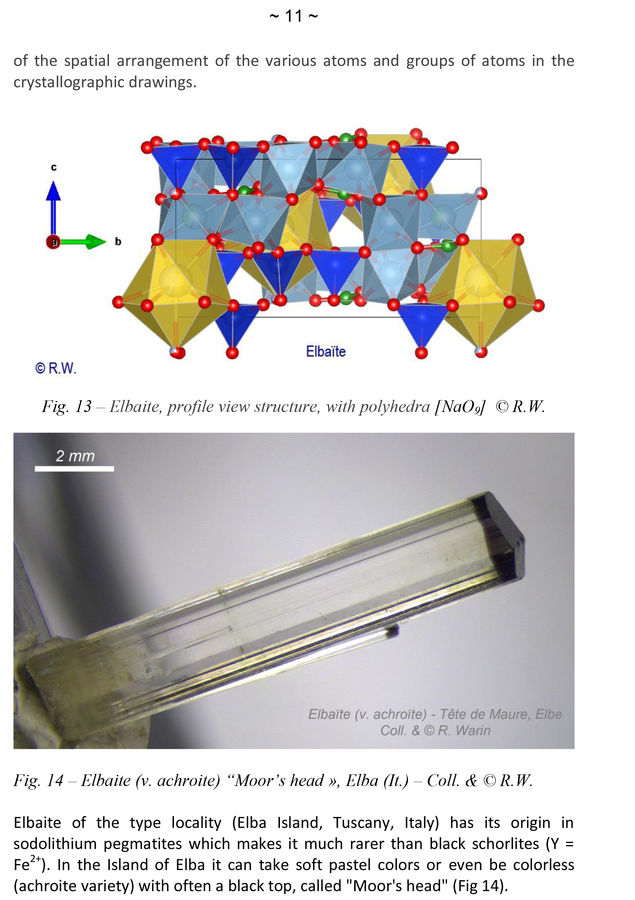Post by 1dave on Nov 2, 2015 13:18:55 GMT -5
Tourmaline: any of a group of crystalline boron silicate minerals of complex composition, containing boron, aluminum, hydrogen, iron, lithium, magnesium, oxygen, potassium, silica, sodium, etc., usually black but having various colored, transparent varieties used as gems, but at 7 to 7.5, Schorl makes a very nice black stone.
Diamond has the simplest formula: C.
Tourmaline the most complex:
(Ca,K,Na,[])(Al,Fe,Li,Mg,Mn)3(Al,Cr, Fe,V)6(BO3)3(Si,Al,B)6O18(OH,F)4
Its general formula can be written as
XY3Z6(T6O18)(BO3)3V3W,
where:
X = Ca, Na, K, ? = vacancy
Y = Li, Mg, Fe2+, Mn2+, Zn, Al, Cr3+, V3+, Fe3+, Ti4+, vacancy
Z = Mg, Al, Fe3+, Cr3+, V3+
T = Si, Al, B
B = B, vacancy
V = OH, O
W = OH, F, O
The tourmaline mineral group is chemically one of the most complicated groups of silicate minerals. Its composition varies widely because of isomorphous replacement as formation solutions changed, but ALL are Boron Silicates.
Because it can have so many variables in composition, it also takes many forms and colors.
The crystals often begin as triangles but end as hexagons. Often growing up as parallel rods then changing to tree like growth rings.

The 31 minerals in the group (endmember formulas) recognized by the International Mineralogical Association
Adachiite - CaFe2+3Al6(Si5AlO18)(BO3)3(OH)3OH
Bosiite - NaFe3+3(Al4Mg2)Si6O18(BO3)3(OH)3O
Chromium-dravite - NaMg3Cr6Si6O18(BO3)3(OH)3OH
Chromo-alumino-povondraite - NaCr3(Al4Mg2)Si6O18(BO3)3(OH)3O
Darrellhenryite - NaLiAl2Al6Si6O18(BO3)3(OH)3O
Dravite - NaMg3Al6Si6O18(BO3)3(OH)3OH
Elbaite - Na(Li1.5,Al1.5)Al6Si6O18(BO3)3(OH)3OH
Feruvite - CaFe2+3(MgAl5)Si6O18(BO3)3(OH)3OH
Fluor-buergerite - NaFe3+3Al6Si6O18(BO3)3O3F
Fluor-dravite - NaMg3Al6Si6O18(BO3)3(OH)3F
Fluor-elbaite - Na(Li1.5,Al1.5)Al6Si6O18(BO3)3(OH)3F
Fluor-liddicoatite - Ca(Li2Al)Al6Si6O18(BO3)3(OH)3F
Fluor-schorl - NaFe2+3Al6Si6O18(BO3)3(OH)3F
Fluor-tsilaisite - NaMn2+3Al6Si6O18(BO3)3(OH)3F
Fluor-uvite - CaMg3(Al5Mg)Si6O18(BO3)3(OH)3F
Foitite - ?(Fe2+2Al)Al6Si6O18(BO3)3(OH)3OH
Luinaite-(OH) - (Na,?)(Fe2+,Mg)3Al6Si6O18(BO3)3(OH)3OH
Magnesio-foitite - ?(Mg2Al)Al6Si6O18(BO3)3(OH)3OH
Maruyamaite - K(MgAl2)(Al5Mg)Si6O18(BO3)3(OH)3O
Olenite - NaAl3Al6Si6O18(BO3)3O3OH
Oxy-chromium-dravite - NaCr3(Mg2Cr4)Si6O18(BO3)3(OH)3O
Oxy-dravite - Na(Al2Mg)(Al5Mg)Si6O18(BO3)3(OH)3O
Oxy-schorl - Na(Fe2+2Al)Al6Si6O18(BO3)3(OH)3O
Oxy-vanadium-dravite - NaV3(V4Mg2)Si6O18(BO3)3(OH)3O
Povondraite - NaFe3+3(Fe3+4Mg2)Si6O18(BO3)3(OH)3O
Rossmanite - ?(LiAl2)Al6Si6O18(BO3)3(OH)3OH
Schorl - NaFe2+3Al6Si6O18(BO3)3(OH)3OH
Tsilaisite NaMn2+3Al6Si6O18(BO3)3(OH)3OH
Uvite - CaMg3(Al5Mg)Si6O18(BO3)3(OH)3OH
Vanadio-oxy-chromium-dravite - NaV3(Cr4Mg2)Si6O18(BO3)3(OH)3O
Vanadio-oxy-dravite - NaV3(Al4Mg2)Si6O18(BO3)3(OH)3O
Species:
Schorl May account for 95% or more of all tourmaline in nature.
Schorl - “Iron Tourmaline.” Brownish black to Black Schorl. The sodium iron (divalent) endmember of the group.
Environment Most often in granite pegmatites; also in skarns.
Rock Type Igneous, Metamorphic


Aquamarine xls on Schorl
Dravite species: named from the Drava river district of Carinthia
Dravite - “Brown Tourmaline,” Dark yellow to brownish black. The sodium magnesium rich tourmaline endmember. NaMg3(Al,Mg)6B3Si6O27(OH)
Dravite forms multiple series with other tourmaline members, including schorl and elbaite.
Dravite varieties include the deep green chromium dravite and the vanadium dravite.
Environment In marble deposits of metamorphosed limestone, metamorphic schists, and in mafic igneous rock and pegmatites. Rock Type Igneous, Metamorphic
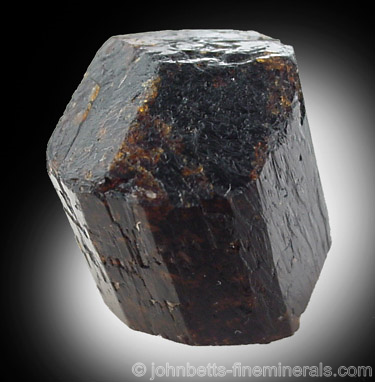
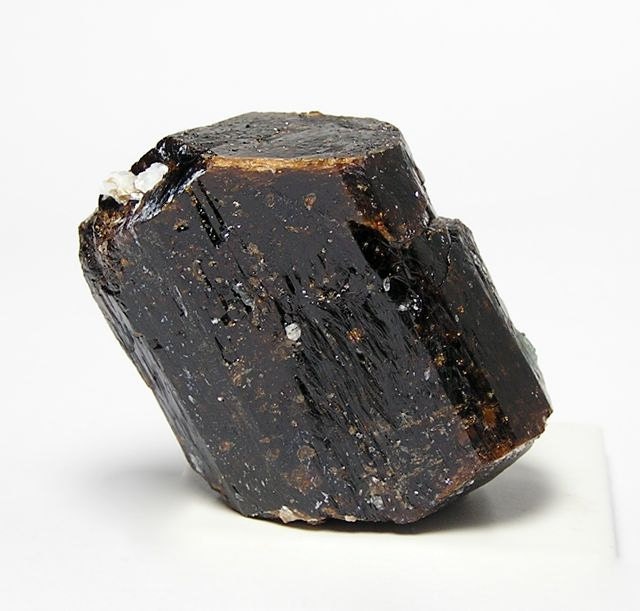
Elbaite species: named after the island of Elba, Italy
Elbaite occurs in lithium bearing granite with a formula similar to Na(Li1.5Al1.5)Al6(BO3)3[Si6O18](OH)3(OH).
It's colorful crystals are considered to be the most valuable.
Watermelon Elbaite:
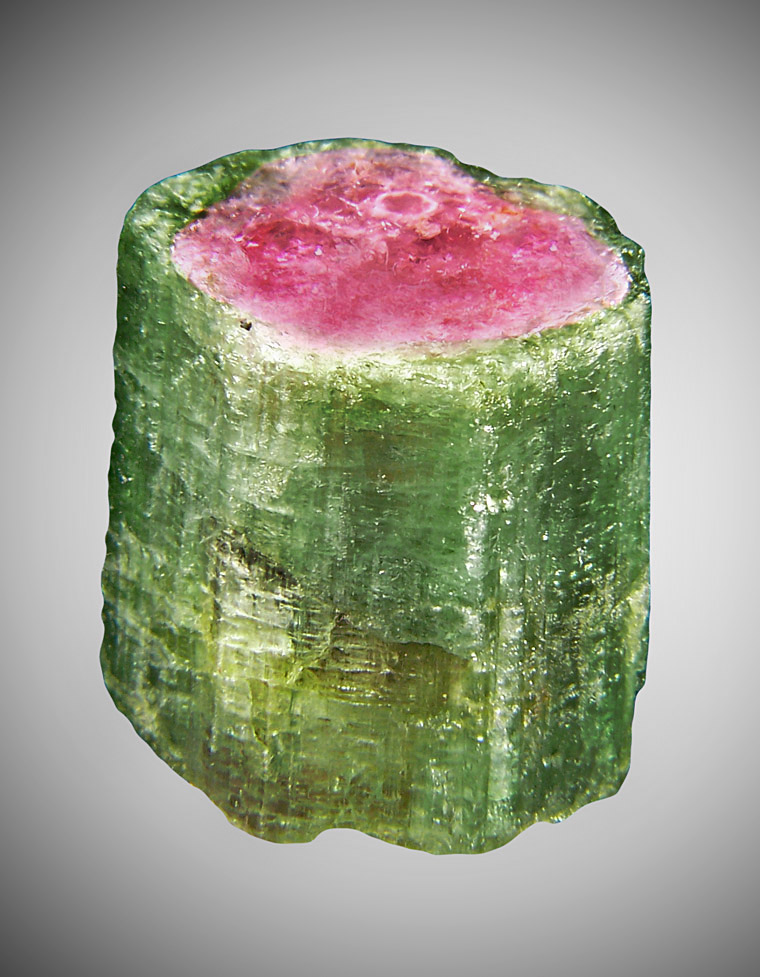


Achroite variety - Colorless (from the Greek meaning "colorless")


Indicolite variety - Light blue to bluish green—Brazilian(from indigo) Color is probably influenced by copper (azurite).
Magnetic blue tourmaline is colored by iron.

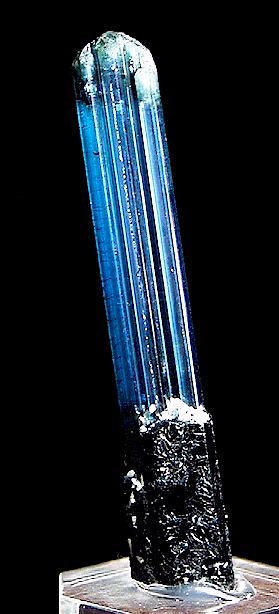
Rubellite variety - Red or pinkish-red (from rubellus) Color of by tourmaline crystals with Mn2+ were initially very pale. Due to natural gamma ray exposure from radioactive decay of 40K in their granitic environment, gradual formation of Mn3+ ions occurs, which is responsible for the deepening of the pink to red color.


Verdite variety - Green or Brazilian emerald Color is probably influenced by copper (malachite).

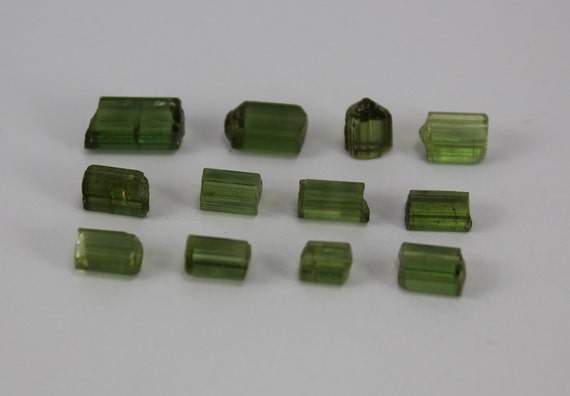
Environment Almost exclusively in granite pegmatites. Rock Type Igneous
Liddicoatite is an uncommon form of Tourmaline, almost identical in chemical composition to Elbaite, but with a calcium atom replacing a sodium atom in its chemical formula.
Liddicoatite watermelon crystals look a tad different.




Liddicoatite was not recognized as a separate Tourmaline species until 1977. Prior to that time, it was thought to be Elbaite. The original discovery of Liddicoatite in Madagascar was believed to be fully dominating in hydroxyl in its chemical formula. Subsequent analysis has determined a fluorine presence in place of some of the hydroxyl, though several localities (though not the type locality) do in fact contain all hydroxyl and no fluorine. The fluorine-rich Liddicoatite is recognized as a distinct mineral species by the IMA, and termed Fluor-liddicoatite. Liddicoatite is name after Richard T. Liddicoat (1918-2002), a well-known gemologist who was the president of the GIA, and inventor of the Diamond grading system.
Chemical Formula Ca(Li,Al)3Al6(BO3)3Si6O18(OH)4
Composition Basic calcium lithium aluminum boro-silicate, sometimes with fluorine partially replacing the hydroxyl
Color Liddicoatite is a very colorful mineral. Colors include green, red, pink, purple, and and blue. White, colorless, black, brown, yellow, and orange colors also exist. Crystals are frequently multicolored, containing two or more distinct colors. Liddicoatite may also have internal color zoning and banding. Some specimens are pleochroic.
Environment In lithium-rich granite pegmatites, and in placer deposits nearby the granite pegmatites. Rock Type Igneous
- See more at: www.minerals.net/mineral/liddicoatite.aspx#sthash.NUnWlLqv.dpuf
Uvite is a calcium magnesium tourmaline. The name Uvite is derived from the type locality of the Uva Province, in Sri Lanka, where it was first identified.


Color Light to dark green, light to dark brown, reddish brown, red, purple, brownish-yellow, white, gray, black. May also be multicolored with light and dark brown streakings.
Environment In metamorphosed Magnesite deposits, and in metamorphic skarns and marbles.
Color
Tourmaline has a variety of colors. Usually, iron-rich tourmalines are black to bluish-black to deep brown, while magnesium-rich varieties are brown to yellow, and lithium-rich tourmalines are almost any color: blue, green, red, yellow, pink, etc. Rarely, it is colorless. Bi-colored and multicolored crystals are common, reflecting variations of fluid chemistry during crystallization. Crystals may be green at one end and pink at the other, or green on the outside and pink inside; this type is called watermelon tourmaline. Some forms of tourmaline are dichroic, in that they change color when viewed from different directions.
The pink color of tourmalines from many fields is the result of prolonged natural irradiation. During their growth, these tourmaline crystals incorporated Mn2+ and were initially very pale. Due to natural gamma ray exposure from radioactive decay of 40K in their granitic environment, gradual formation of Mn3+ ions occurs, which is responsible for the deepening of the pink to red color.
Tourmaline is found in granite and granite pegmatites and in metamorphic rocks such as schist and marble. Schorl and lithium-rich tourmalines are usually found in granite and granite pegmatite. Magnesium-rich tourmalines, dravites, are generally restricted to schists and marble. Tourmaline is a durable mineral and can be found in minor amounts as grains in sandstone and conglomerate, and highly weathered sediments.

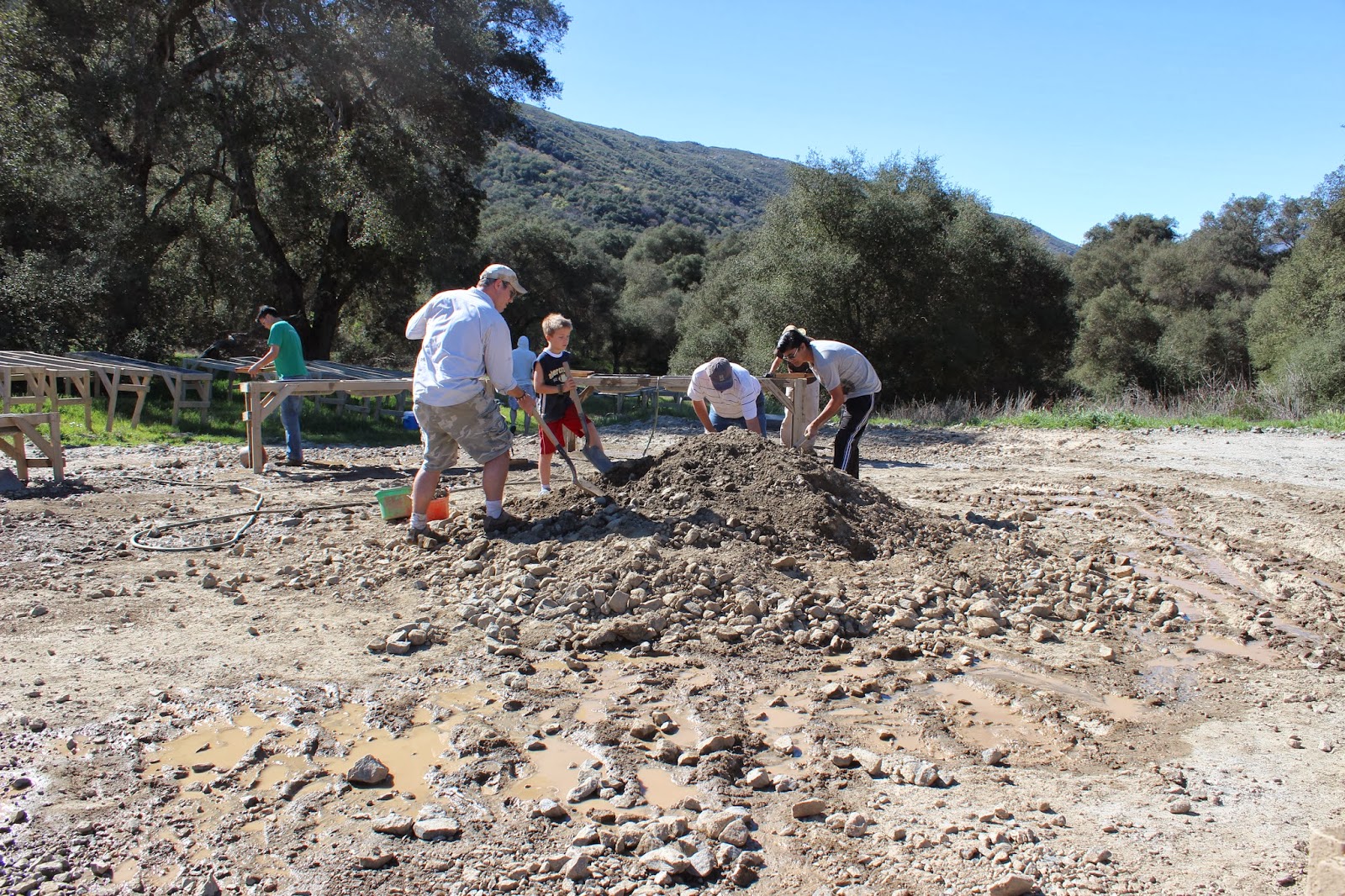
Diamond has the simplest formula: C.
Tourmaline the most complex:
(Ca,K,Na,[])(Al,Fe,Li,Mg,Mn)3(Al,Cr, Fe,V)6(BO3)3(Si,Al,B)6O18(OH,F)4
Its general formula can be written as
XY3Z6(T6O18)(BO3)3V3W,
where:
X = Ca, Na, K, ? = vacancy
Y = Li, Mg, Fe2+, Mn2+, Zn, Al, Cr3+, V3+, Fe3+, Ti4+, vacancy
Z = Mg, Al, Fe3+, Cr3+, V3+
T = Si, Al, B
B = B, vacancy
V = OH, O
W = OH, F, O
The tourmaline mineral group is chemically one of the most complicated groups of silicate minerals. Its composition varies widely because of isomorphous replacement as formation solutions changed, but ALL are Boron Silicates.
Because it can have so many variables in composition, it also takes many forms and colors.
The crystals often begin as triangles but end as hexagons. Often growing up as parallel rods then changing to tree like growth rings.

The 31 minerals in the group (endmember formulas) recognized by the International Mineralogical Association
Adachiite - CaFe2+3Al6(Si5AlO18)(BO3)3(OH)3OH
Bosiite - NaFe3+3(Al4Mg2)Si6O18(BO3)3(OH)3O
Chromium-dravite - NaMg3Cr6Si6O18(BO3)3(OH)3OH
Chromo-alumino-povondraite - NaCr3(Al4Mg2)Si6O18(BO3)3(OH)3O
Darrellhenryite - NaLiAl2Al6Si6O18(BO3)3(OH)3O
Dravite - NaMg3Al6Si6O18(BO3)3(OH)3OH
Elbaite - Na(Li1.5,Al1.5)Al6Si6O18(BO3)3(OH)3OH
Feruvite - CaFe2+3(MgAl5)Si6O18(BO3)3(OH)3OH
Fluor-buergerite - NaFe3+3Al6Si6O18(BO3)3O3F
Fluor-dravite - NaMg3Al6Si6O18(BO3)3(OH)3F
Fluor-elbaite - Na(Li1.5,Al1.5)Al6Si6O18(BO3)3(OH)3F
Fluor-liddicoatite - Ca(Li2Al)Al6Si6O18(BO3)3(OH)3F
Fluor-schorl - NaFe2+3Al6Si6O18(BO3)3(OH)3F
Fluor-tsilaisite - NaMn2+3Al6Si6O18(BO3)3(OH)3F
Fluor-uvite - CaMg3(Al5Mg)Si6O18(BO3)3(OH)3F
Foitite - ?(Fe2+2Al)Al6Si6O18(BO3)3(OH)3OH
Luinaite-(OH) - (Na,?)(Fe2+,Mg)3Al6Si6O18(BO3)3(OH)3OH
Magnesio-foitite - ?(Mg2Al)Al6Si6O18(BO3)3(OH)3OH
Maruyamaite - K(MgAl2)(Al5Mg)Si6O18(BO3)3(OH)3O
Olenite - NaAl3Al6Si6O18(BO3)3O3OH
Oxy-chromium-dravite - NaCr3(Mg2Cr4)Si6O18(BO3)3(OH)3O
Oxy-dravite - Na(Al2Mg)(Al5Mg)Si6O18(BO3)3(OH)3O
Oxy-schorl - Na(Fe2+2Al)Al6Si6O18(BO3)3(OH)3O
Oxy-vanadium-dravite - NaV3(V4Mg2)Si6O18(BO3)3(OH)3O
Povondraite - NaFe3+3(Fe3+4Mg2)Si6O18(BO3)3(OH)3O
Rossmanite - ?(LiAl2)Al6Si6O18(BO3)3(OH)3OH
Schorl - NaFe2+3Al6Si6O18(BO3)3(OH)3OH
Tsilaisite NaMn2+3Al6Si6O18(BO3)3(OH)3OH
Uvite - CaMg3(Al5Mg)Si6O18(BO3)3(OH)3OH
Vanadio-oxy-chromium-dravite - NaV3(Cr4Mg2)Si6O18(BO3)3(OH)3O
Vanadio-oxy-dravite - NaV3(Al4Mg2)Si6O18(BO3)3(OH)3O
Species:
Schorl May account for 95% or more of all tourmaline in nature.
Schorl - “Iron Tourmaline.” Brownish black to Black Schorl. The sodium iron (divalent) endmember of the group.
Environment Most often in granite pegmatites; also in skarns.
Rock Type Igneous, Metamorphic


Aquamarine xls on Schorl
Dravite species: named from the Drava river district of Carinthia
Dravite - “Brown Tourmaline,” Dark yellow to brownish black. The sodium magnesium rich tourmaline endmember. NaMg3(Al,Mg)6B3Si6O27(OH)
Dravite forms multiple series with other tourmaline members, including schorl and elbaite.
Dravite varieties include the deep green chromium dravite and the vanadium dravite.
Environment In marble deposits of metamorphosed limestone, metamorphic schists, and in mafic igneous rock and pegmatites. Rock Type Igneous, Metamorphic


Elbaite species: named after the island of Elba, Italy
Elbaite occurs in lithium bearing granite with a formula similar to Na(Li1.5Al1.5)Al6(BO3)3[Si6O18](OH)3(OH).
It's colorful crystals are considered to be the most valuable.
Watermelon Elbaite:



Achroite variety - Colorless (from the Greek meaning "colorless")


Indicolite variety - Light blue to bluish green—Brazilian(from indigo) Color is probably influenced by copper (azurite).
Magnetic blue tourmaline is colored by iron.


Rubellite variety - Red or pinkish-red (from rubellus) Color of by tourmaline crystals with Mn2+ were initially very pale. Due to natural gamma ray exposure from radioactive decay of 40K in their granitic environment, gradual formation of Mn3+ ions occurs, which is responsible for the deepening of the pink to red color.


Verdite variety - Green or Brazilian emerald Color is probably influenced by copper (malachite).


Environment Almost exclusively in granite pegmatites. Rock Type Igneous
Liddicoatite is an uncommon form of Tourmaline, almost identical in chemical composition to Elbaite, but with a calcium atom replacing a sodium atom in its chemical formula.
Liddicoatite watermelon crystals look a tad different.




Liddicoatite was not recognized as a separate Tourmaline species until 1977. Prior to that time, it was thought to be Elbaite. The original discovery of Liddicoatite in Madagascar was believed to be fully dominating in hydroxyl in its chemical formula. Subsequent analysis has determined a fluorine presence in place of some of the hydroxyl, though several localities (though not the type locality) do in fact contain all hydroxyl and no fluorine. The fluorine-rich Liddicoatite is recognized as a distinct mineral species by the IMA, and termed Fluor-liddicoatite. Liddicoatite is name after Richard T. Liddicoat (1918-2002), a well-known gemologist who was the president of the GIA, and inventor of the Diamond grading system.
Chemical Formula Ca(Li,Al)3Al6(BO3)3Si6O18(OH)4
Composition Basic calcium lithium aluminum boro-silicate, sometimes with fluorine partially replacing the hydroxyl
Color Liddicoatite is a very colorful mineral. Colors include green, red, pink, purple, and and blue. White, colorless, black, brown, yellow, and orange colors also exist. Crystals are frequently multicolored, containing two or more distinct colors. Liddicoatite may also have internal color zoning and banding. Some specimens are pleochroic.
Environment In lithium-rich granite pegmatites, and in placer deposits nearby the granite pegmatites. Rock Type Igneous
- See more at: www.minerals.net/mineral/liddicoatite.aspx#sthash.NUnWlLqv.dpuf
Uvite is a calcium magnesium tourmaline. The name Uvite is derived from the type locality of the Uva Province, in Sri Lanka, where it was first identified.


Color Light to dark green, light to dark brown, reddish brown, red, purple, brownish-yellow, white, gray, black. May also be multicolored with light and dark brown streakings.
Environment In metamorphosed Magnesite deposits, and in metamorphic skarns and marbles.
Color
Tourmaline has a variety of colors. Usually, iron-rich tourmalines are black to bluish-black to deep brown, while magnesium-rich varieties are brown to yellow, and lithium-rich tourmalines are almost any color: blue, green, red, yellow, pink, etc. Rarely, it is colorless. Bi-colored and multicolored crystals are common, reflecting variations of fluid chemistry during crystallization. Crystals may be green at one end and pink at the other, or green on the outside and pink inside; this type is called watermelon tourmaline. Some forms of tourmaline are dichroic, in that they change color when viewed from different directions.
The pink color of tourmalines from many fields is the result of prolonged natural irradiation. During their growth, these tourmaline crystals incorporated Mn2+ and were initially very pale. Due to natural gamma ray exposure from radioactive decay of 40K in their granitic environment, gradual formation of Mn3+ ions occurs, which is responsible for the deepening of the pink to red color.
Tourmaline is found in granite and granite pegmatites and in metamorphic rocks such as schist and marble. Schorl and lithium-rich tourmalines are usually found in granite and granite pegmatite. Magnesium-rich tourmalines, dravites, are generally restricted to schists and marble. Tourmaline is a durable mineral and can be found in minor amounts as grains in sandstone and conglomerate, and highly weathered sediments.

.. on the Money: Himalayan Tourmaline Mine Trip Gem Dig in California

 Anyone able to provide photos of the above?
Anyone able to provide photos of the above? 


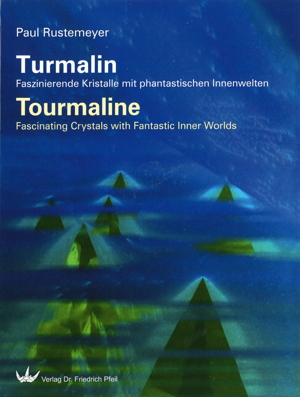
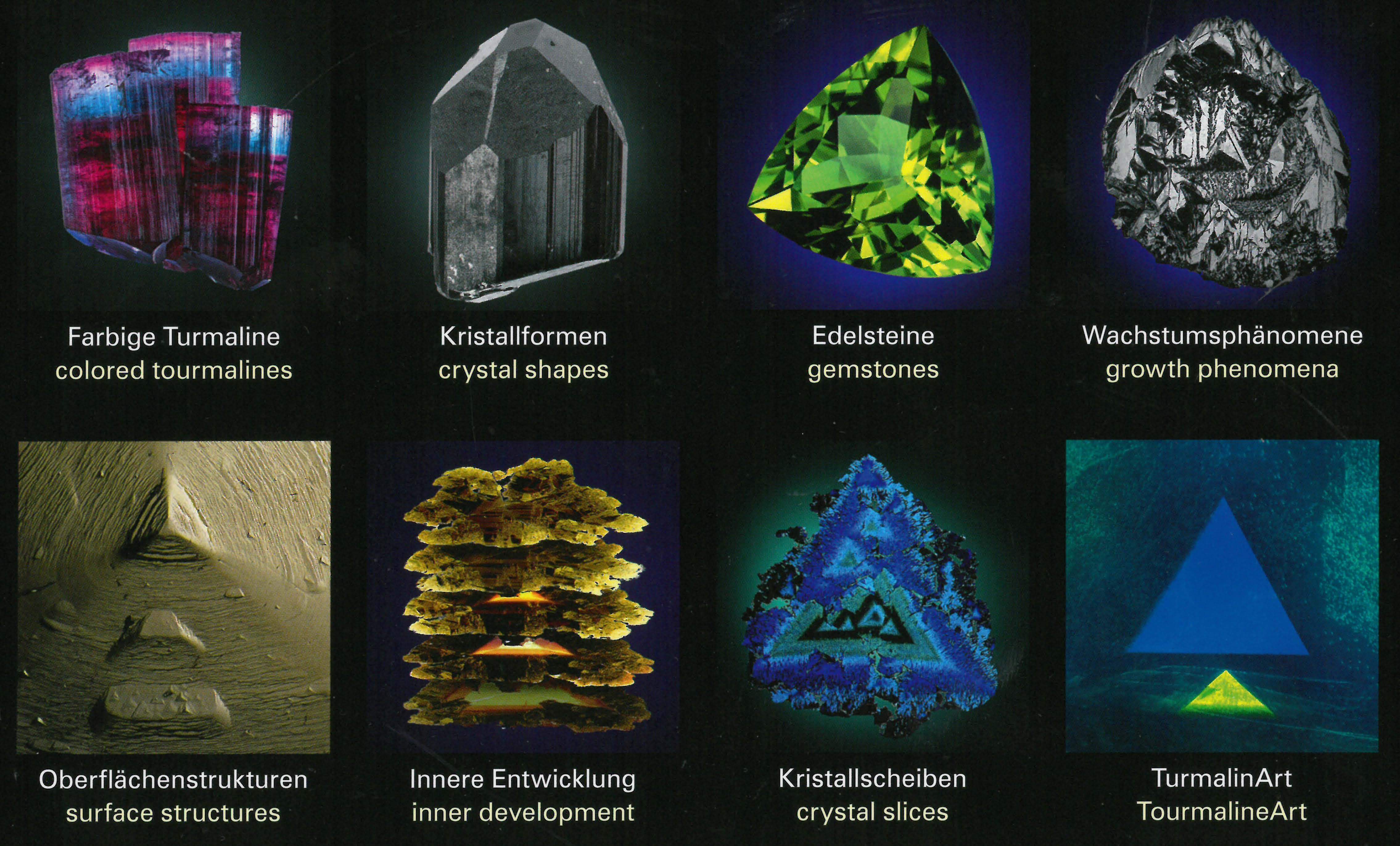
 Perhaps not.
Perhaps not.


